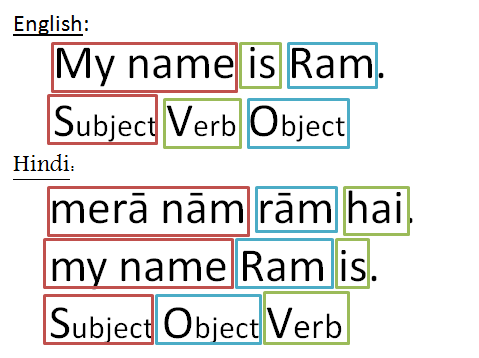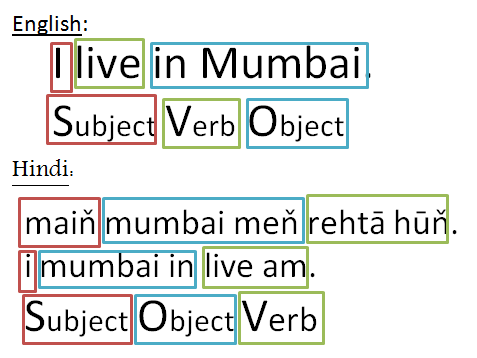English is an SVO(Subject-Verb-Object) language while Hindi is an SOV(Subject-Object-Verb) language.
Let’s look at the first example.

See the colour groups for faster understanding. Let’s see one more example.

Note:
1. A ‘to be’ helping verb is required in most of the Hindi sentences.
2. In Devanagari, there is no concept that ‘a sentence starts with a capital letter’ or ‘a proper noun starts with a capital letter’. All letters are of same size for all words.
1 Comment | tags: basic hindi, hindi sentence, hindi sentence structure | posted in Grammar, Speaking, Structure
These are the most basic Hindi sentences using ‘to be’ forms with first person, second person & third person pronouns.
| मैं हूं। |
maiň hūň. |
I am. |
| हम हैं। |
ham haiň. |
We are. |
| तू है। |
tu hai. |
You are. (Informal) |
| तुम हो। |
tum ho. |
You are. (Little formal/Plural) |
| आप हैं। |
āp haiň. |
You are. (Formal/Plural) |
| वह है। |
vah hai. *vo hai.( In spoken)* |
He/She/It is. |
| वे हैं। |
ve haiň. *vo hai.( In spoken)* |
They are. (Formal/Plural) |
1 Comment | tags: basic hindi, hindi common words, hindi sentence structure, hindi verbs, hona, to be | posted in Grammar, Speaking, Structure
In Hindi, infinitive = root verb + nā
So if root verb is kar then karnā is the infinitive.
| करना |
karnā |
To do |
| मुस्कराना |
muskarānā |
To smile |
| हंसना |
hasnā |
To laugh |
| रोना |
ronā |
To cry |
| बजाना |
bajānā |
To play (musical instrument) |
| ताली बजाना |
tālī bajānā |
To clap |
| खडा होना |
khadā honā |
To stand |
| बैठना |
baithnā |
To sit |
| चलना |
chalnā |
To walk |
| दौडना |
daudnā |
To run |
| खाना |
khānā |
To eat |
| पीना |
pīnā |
To drink |
| पढना |
padhnā |
To read/study |
| पढाना |
padhānā |
To teach |
| लिखना |
likhnā |
To write |
| फेंकना |
feknā |
To throw |
| पकडना |
pakadnā |
To catch |
| कूदना |
kūdnā |
To jump |
| खेलना |
khelnā |
To play |
| तैरना |
tairnā |
To swim |
| नाचना |
nāchnā |
To dance |
| सोना |
sonā |
To sleep |
| पकाना |
pakānā |
To cook |
| बताना |
batānā |
To tell |
| बात करना |
bāt karnā |
To talk |
| बोलना |
bolnā |
To speak |
| देखना |
dekhnā |
To see |
| सुनना |
sunnā |
To hear/listen |
| नहाना |
nahānā |
To bathe |
| लेना |
lenā |
To take |
| देना |
denā |
To give |
| आना |
ānā |
To come |
| जाना |
jānā |
To go |
| मारना |
mārnā |
To hit/kill |
| बेचना |
bechnā |
To sell |
| खरीदना |
kharīdnā |
To buy |
1 Comment | tags: hindi action words, hindi common words, hindi grammar, hindi verbs, speaking | posted in Grammar, Speaking





